Dreadnought Arena Combat
Concept: John Wakelin
Rule Mechanics: Russ Wakelin
Copyright 2001 Brok & Lok, LLC
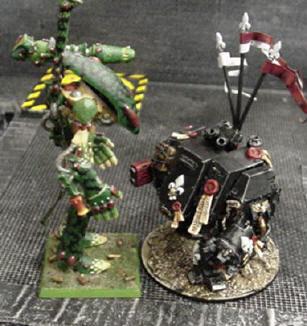 Jamie Hatcher's Wraithlord along with Darren's Sister of Battle dread
Jamie Hatcher's Wraithlord along with Darren's Sister of Battle dread
The Game
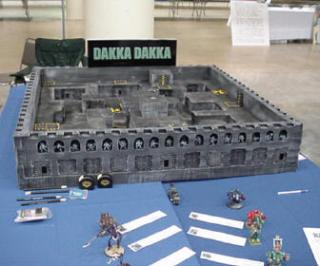 Dakka's 2002 US Game-day Dreadnought Arena Combat table
Dakka's 2002 US Game-day Dreadnought Arena Combat tableDreadnought Arena Combat (DAC) is meant to be a fast and furious multi-player game that can be completed in a little over an hour. The game plays best with a referee to help keep things moving, and a time limit to make sure players feel the pressure (no skulking behind walls all game). The object is to get as many kills as possible. In a case of a tie the war machine (beast) that lived longest is the winner. But remember, the main goal is to kill, not to live!
Choose Your Champion
Each player must first select his war machine (beast) that will do battle. The following are allowed: Dreadnoughts, Wraithlords, Carnifex (and mutations), Killa Kans. There is a 120 point limit. This limit is in place to limit long range firepower. DAC should focus on hand to hand combat. Shooting should not be the primary way to kill! The vehicle design rules are allowed if players would like to include other wacky machines, but keep an eye on that point limit.
A note about extra armor: Because of the way our penetration table’s work, extra armor gives a 6+ invulnerable save instead of its normal effect. (Just like ork armor plates).
Setup
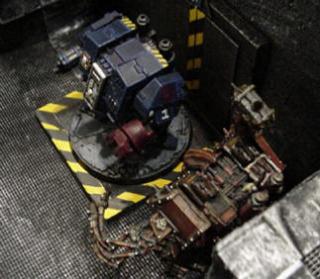 Ken Upton's Crimson fist dread
Ken Upton's Crimson fist dreadEach player will need a small piece of paper and a pen to keep track of various things as the game progresses. The referee will need a bag/hat/cup to put a small slip of paper in with each player’s name.
The Turn
The game is really very simple:
- 1. Referee pulls out a random name from the bag, calls it out, and sets it aside.
- 2. That player then:
- A. Moves
- B. Shoots
- C. Assaults
- 3. Repeat steps 1 & 2 until the name bag is empty.
- 4. When bag is empty mix up all the names, throw them back into the bag, and start at 1 again.
All this continues until you either run out of time, or everyone is dead. Whichever comes first.
Movement
Movement works just like Warhammer 40,000 movement rules, with one addition: You can run. Running doubles your movement, and you can run through difficult terrain (roll 2D6, pick the highest, and double it).
Note that if you run you may not assault nor shoot. Also note that you can't run if you start your movement within 8 inches of an enemy war machine/beast.
Shooting
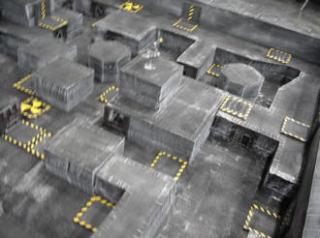 Craig Gallant built this arena specially for Games Day
Craig Gallant built this arena specially for Games DayShooting also works just like Warhammer 40,000, except when it comes to the glancing and penetration tables. To make things more exciting we've developed our own set of penetration/wound tables. Resolve all your shooting at a particular target and add up all the glances and penetrating hits.
Glancing hits simply prevent the target from shooting in the next turn and reduce his hand to hand attacks by 1 for the next turn. Glances are cumulative, so two glances would mean a Marine Dreadnought would have -2 attacks in the next turn.
Note that under DAC rules you can also glance creatures with wounds as well.
Whenever you miss a roll to wound by one, it counts as a glance. For example: An assault cannon firing at a Toughness 6 Carnifex would glance on a 3 and would on a 4. The beast still gets its armor save as normal.
Penetrations work a bit differently. Add up all the penetrations/wounds before rolling on any table. The number of penetrations/wounds you cause dictates which table you roll on. Some weapons are so powerful that they can do multiple penetrations in a single shot! These are listed in the shooting section of the tables.
Note that the total number of wounds a creature has is irrelevant under this system. It stays in play until the results on the tables indicate otherwise.
Example 1: You're closing in on the ork dreadnought. First you spray him with your assault cannon hitting him three times and rolling two 6's against his armor! This yields two glances, thus he is at -2 attacks. You now charge, confident that your gunfire has thrown him off balance enough so that he will do little damage to you in the assault phase. (The charging Dread will have 3 attacks, while the ork will have been reduced to 1)
Example 2: A Wraithlord fires his Star Cannon at a Carnifex. He scores two hits, both of which wound. The Wraithlord player then rolls one D6 and consults the "2 Pen/Wound" table. He rolls a 3: -1 Strength. The Carnifex player makes a note of this on his scrap of paper.
Assaulting
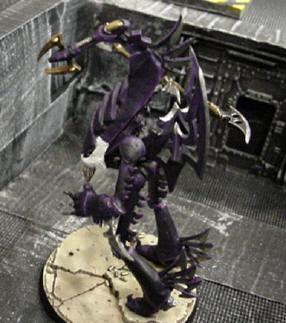 Darren Douglas' Dark Eldar Wraith Lord
Darren Douglas' Dark Eldar Wraith LordThe assault phase works very similar to the Warhammer 40,000 assault phase. However just before assaulting or making his attacks a player may elect to perform a 'special move'. Special moves are listed in the "Tables" section below. Unless otherwise stated special moves can only be used in the assault phase. Some moves can only be done on the turn you move in, while others can be attempted in each round of combat during assaults that go for several turns.
Attacks are worked out in initiative order. If initiative is equal players roll dice to see who gets to swing first. The first player swings, works out how many glancing and penetrating hits he gets, and then rolls on the correct table and the results are applied immediately before the other player gets to swing. Assuming he survives the initial attack he can now swing back.
Note that every time a players name comes out of the bag, all the models involved in a combat that he/she is involved in get to fight.
Example: A Razorfex (bio-construct with 5 strength 6 attacks) charges an Orc Dread. The Razorfex has the higher initiative so he rolls his 6 attacks (5 + 1 for charging). 4 manage to hit. 1 is a glance and the other three are full penetrations. He rolls on the 3 pen chart and gets a 1, ripping off one of the ork machine's legs.
The ork now gets to swing back. But first he must make a Leadership test to remain standing, passing that he decides to go for the claw spin. He succeeds and manages to roll a 6 for his number of attacks!! Unfortunately the Razorfex had scored a glance, so the ork now rolls 5 attacks and sees how he does.
Death Comes in many forms
Besides being killed by a death blow or a Bio/Overload a contestant is destroyed if he is knocked over and has 0 movement left (can't stand up) or can no longer move or shoot (e.g. immobile with both arms blown of.) The player who gets the kill is the one who did the damage that resulted in the machine's demise. If a contestant dies from failing an overload test the player who got the first overload hit gets the credit. (yes, even if that player is already dead.)
The Tables
Glances
Can’t Shoot & -1 Attack. (Cumulative)
1 Penetration/wound
- 1-2) Can’t Shoot
- 3) Stumble: -1 Movement next turn
- 4) Staggered: -1 Movement & Attack Next Turn
- 5) Knock Down: Must spend next turn standing up (Can't shoot or fight while down. In the turn you stand you suffer a -1 to hit when shooting and always strike last in combat.)
- 6) Roll on 2 Pen chart at -1
2 Penetrations/wounds
- 0-2) Engine Damage/Muscle Torn: Perm –2 movement. (cumulative)
- 3) Arm Damage: -1 Strength (cumulative)
- 4) Head/Controls Slammed: -1 Leadership for rest of battle (cumulative)
- 5) Bio/Overload: Rest of Game Ld test before each action. Failed results in death. -1 to LD test for each time this result is rolled on same dread/monster. (cumulative)
- 6) Roll on 3 Pen chart at -1
3 Penetrations/wounds
- -2) Major Leg Damage: ½ Movement, Ld Test each turn or fall over. 2nd result yields 0 movement.
- 3) Arm Blown off: Random army lost. –1 Attack & lost weapon(s) for remainder of game.
- 4) System/Bio Overload: Rest of Game LD - 2 test before each action. Failed test results in destruction. (cumulative)
- 5-6) Death Blow: Destroyed.
Shooting
All Strength 8 or better weapons score 2 penetrations/wounds instead of one on a D6 roll of 4+.
All Melta within half Range score D3 penetrations/wounds instead of one.
‘Always Glance’ weapons can get to roll on the 1 penetration/wound table.
General Moves
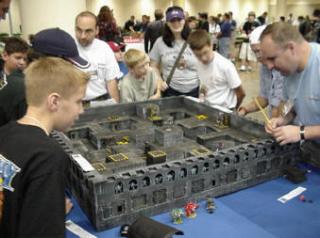 Folks seemed to really enjoy the whole concept as every round was full of fanatic Dreadnought commanders
Folks seemed to really enjoy the whole concept as every round was full of fanatic Dreadnought commandersNote that moves require leadership tests to be performed. All combatants are considered to start the event with Leadership 10. Modifiers are subtracted from the contestant’s current leadership, thus making it more difficult to roll under the number on two D6.
- Slam Charge: Can be performed if contestant did not move or shoot this turn. There are no modifiers to the leadership test. Triples assault range straight at opponent. Success yields +1 Attack at +1 strength. Failure results in no movement taking place. This move can not be performed if you are already in combat.
- Shove: Modifier: Opponents Init. Success pushes opponent back D6” with no attacks this also breaks off hand to hand combat. Failure means no attacks. Can be done whenever you have the opportunity to attack.
- Death from Above: No modifiers. Failure results in fall counting as 6”. Success is +2 Attacks and +2 Strength. Must be in a higher position to perform this move. This move can not be performed if you are already in combat.
- Foot Sweep: Only attack performed when knocked down. Modifier: Opponent’s init. Success you stand and he falls. Failure means can’t stand up in next movement.
Race Specific Moves
These moves can only be performed by certain races.
- Space Marines: Rending Attack: Each penetration counts for 2. Modifier: Opponents Init. If opponent down/stunned then no modifier. Failure means no attacks. Can be done whenever you have the opportunity to attack.
- Eldar: Akido: Move can be performed whenever Slam or Death from above move used against a wraithlord. – Modifier: –2. Failure means no attacks in combat. Success means attacker is knocked down and 1" away from Eldar (assault failed).
- Carnefex: Death Hug: Modifier: Opponent's Init. If opponent Stunned or knocked down then no mod. Success does D6 attacks per turn if opponent doesn't break free. To break free both roll D6 + Strength. Highest wins. Can be done whenever you have the opportunity to attack.
- Ork Kan/Dread: Claw Spin: Modifier: -2. D6 Attacks. Failure means no attacks. Can be done whenever you have the opportunity to attack.
- Talos: Death Drop: Ld Check at no mod. Failure means no attack. Success allows “Death from above” without using terrain. This move can not be performed if you are already in combat.
- Chaos: Rage: Modifier: – 3. Success doubles attacks at –1 WS! Failure means no attacks. Can be done whenever you have the opportunity to attack.
Other
+1 to hit prone target in hand to hand combat.
Falling: D6 strength X hits on back armor. X is the height of the fall in inches.
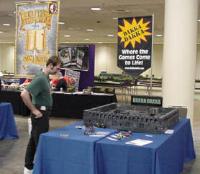 This was the first year that clubs were allowed to participate in Games Day
This was the first year that clubs were allowed to participate in Games Day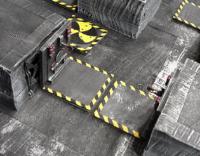 Dreadnought Arena was envisioned as 40k meet Battlebots. So the arena was filled with hazards such as flamers, spinners...
Dreadnought Arena was envisioned as 40k meet Battlebots. So the arena was filled with hazards such as flamers, spinners...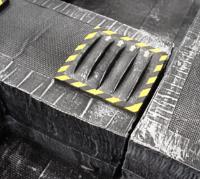 ...buzzsaws and more!
...buzzsaws and more!